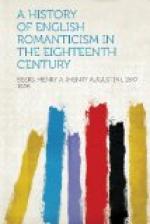[4] For a full discussion of Gray’s sources and of his knowledge of Old Norse, the reader should consult the appendix by Professor G. L. Kittredge to Professor W. L. Phelps’ “Selections from Gray” (1894, pp. xl-1.) Professor Kittredge concludes that Gray had but a slight knowledge of Norse, that he followed the Latin of Bartholin in his renderings; and that he probably also made use of such authorities as Torfaeus’ “Orcades” (1697), Ole Worm’s “Literatura Runica” (Copenhagen, 1636), Dr. George Hickes’ monumental “Thesaurus” (Oxford, 1705), and Robert Sheringham’s “De Anglorum Gentis Origine Disceptatio” (1716). Dryden’s “Miscellany Poems” (1716) has a verse translation, “The Waking of Angantyr,” from the English prose of Hickes, of a portion of the “Hervarar Saga.” Professor Kittredge refers to Sir William Temple’s essays “Of Poetry” and “Of Heroic Virtue.” “Nichols’ Anecdotes” (I. 116) mentions, as published in 1715, “The Rudiments of Grammar for the English Saxon Tongue; with an Apology for the study of Northern Antiquities.” This was by Mrs. Elizabeth Elstob, and was addressed to Hickes, the compiler of the “Thesaurus.”
[5] “Some Specimens of the Poetry of the Ancient Welsh Bards, translated into English,” by Rev. Evan Evans, 1764. The specimens were ten in number. The translations were in English prose. The originals were printed from a copy which Davies, the author of the Welsh dictionary, had made of an ancient vellum MS. thought to be of the time of Edward II, Edward III, and Henry V. The book included a Latin “Dissertatio de Bardis,” together with notes, appendices, etc. The preface makes mention of Macpherson’s recently published Ossianic poems.
[6] “Life of Gray.”
[7] See Phelps’ “English Romantic Movement,” pp. 73, 141-42.
[8] Wm Dugdale published his “Monasticon Anglicanum,” a history of English religious houses, in three parts, in 1655-62-73. It was accompanied with illustrations of the costumes worn by the ancient religious orders, and with architectural views. The latter, says Eastlake, were rude and unsatisfactory, but interesting to modern students, as “preserving representations of buildings, or portions of buildings, no longer in existence; as, for instance, the campanile, or detached belfry of Salisbury, since removed, and the spire of Lincoln, destroyed in 1547.”
[9] “Verses on Sir Joshua Reynolds’ Painted Window.” Cf. Poe, “To Helen”:
“On desperate seas long
wont to roam
Thy hyacinth hair, thy classic
face,
Thy Naiad airs have brought
me home
To the glory that was Greece,
And the grandeur that was
Rome.”
[10] This apology should be compared with Scott’s verse epistle to Wm Ereskine, prefixed to the third canto of “Marmion.”
“For
me, thus nurtured, dost thou ask
The classic poet’s well-conned
task?” etc.
Scott spoke of himself in Warton’s exact language, as a “truant to the classic page.”




